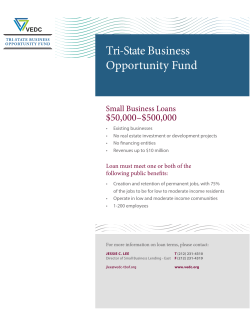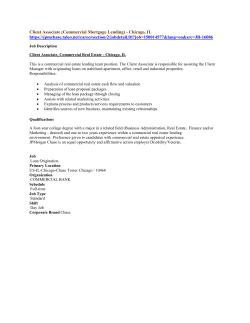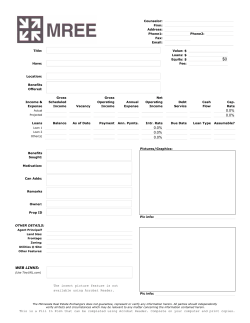
Life Insurance-Premium Financing
Life Insurance-Premium Financing BY MATT HEALY – MANAGING DIRECTOR, CLIENT RISK MANAGEMENT Life Insurance-Premium Financing BY MATT HEALY – MANAGING DIRECTOR, CLIENT RISK MANAGEMENT EXECUTIVE SUMMARY Life insurance can play an important role in helping achieve the legacy and financial objectives of an individual or family—especially those with significant taxable estates and illiquid assets such as privately held businesses and real estate. For those who have assets that exceed the federal estate tax-exemption thresholds—$5,430,000 for an individual, potentially $10,860,000 for a married couple in 2015 (both amounts indexed annually for inflation)—the concern is that a large portion of assets in the estate (meant for beneficiaries to be received in-kind) may have to be liquidated to pay estate taxes. Life insurance can be a key in meeting the liquidity needs when selling assets is not the best choice. When you determine that life insurance is the ideal strategy to meet your liquidity needs, it’s important to choose the appropriate amount of coverage and type of policy. The next step is to decide how to fund the policy. Cash may be available to pay for policy premiums, but you may want to avoid reducing available cash reserves. Selling existing portfolio positions is another option, but this approach is not always desirable. Certain assets aren’t easily liquidated, and even when they are, doing so may have unfavorable tax implications. Selling assets to free up cash may also eliminate the opportunity to potentially generate additional returns from the assets that were sold, or, in the case of a business, may have an impact on its balance sheet. Life insurance can be a key resource in meeting liquidity needs when selling assets is not the best choice. FINANCING FOR PREMIUMS As an alternative approach to funding a policy, you may want to consider the potential advantages of financing life insurance premiums, which may provide a policy owner more financial flexibility. This approach involves leveraging your existing assets rather than liquidating them. Premium financing may make the purchase of life insurance more convenient if your assets are not readily liquid or if you prefer to retain those assets and avoid having to alter your cash flow. Liquidating assets may be neither efficient nor desirable depending on market conditions, tax implications or potential for future capital appreciation. Premium financing may also provide certain tax advantages, which should be discussed with your tax advisor. 1 Insights Life Insurance-Premium Financing When life insurance policies are owned inside an irrevocable life insurance trust (ILIT), a number of important estate and gift tax issues must be considered. If you’ve already established a financing arrangement to pay premiums on an existing policy, it may be worth considering whether refinancing the loan makes sense. A comparison of terms between your existing premium financing plan and an updated arrangement can help determine if refinancing is a cost-efficient option. As with any complex financial strategy, consult with your financial, legal and tax advisors to assess the benefits of a financing approach to premium payments. TAX ISSUES WHEN FUNDING INSURANCE THROUGH A TRUST When life insurance policies are owned inside an irrevocable life insurance trust (ILIT), a number of important estate and gift tax issues must be considered. When an ILIT is established, the grantor of the trust provides funding via gifts so the trust can purchase the insurance policy. The trustee of the ILIT names the trust as the beneficiary of the insurance proceeds. Upon death, the trust beneficiaries are paid in accordance with the terms of the trust, and the insurance proceeds may be passed on to beneficiaries of the trust free of income tax and estate tax.1 The insurance proceeds may replace the value lost to taxes when the estate settles. Alternatively, if the estate is distributing assets that are not liquid (e.g., a business or real estate) or investments that may otherwise have to be sold at an inopportune time to meet the tax liability, insurance proceeds can be used as an option to cover taxes and other estate settlement costs. An important factor to consider in determining the source of funding to pay premiums is gift taxes. If existing assets are directed to the trust (either as an outright gift or as a private loan) to pay for life insurance premiums, the sum of the gifts or the forgiveness of any loan interest or principal balance may be sufficient to trigger gift-tax consequences and count against the unified gift and federal estate tax lifetime exemption. (In 2015 gift taxes apply on gifts of greater than $14,000 per beneficiary. That number is inflation-adjusted periodically. The lifetime exemption for gift and estate taxes is $5,430,000 in 2015, adjusted annually for inflation). Consideration should also be given to the potential impact of estate taxes at the state level. Financing life insurance may allow you to amplify the power of these exemptions. The ILIT could borrow the funds from U.S. Bank or a third-party lender to make premium payments, with gifts or exemptions covering the annual interest costs on the borrowed amount. 1 2 ife insurance death benefit proceeds are generally excludable from the beneficiary’s gross income for income tax L purposes pursuant to IRC Sec. 101(a)(1). There are exceptions, such as when a life insurance policy has been transferred for valuable consideration. If an ILIT is established and named as owner and beneficiary of the policy, the policy’s death benefit is generally able to pass to the heirs estate tax free. Please consult a tax advisor for more information. Life Insurance-Premium Financing (ILIT as Insurance Owner) Most insurance companies require a review of any Bank Grantor of Trust Bank makes loan to trust to fund premiums Trust repays loan to the bank $ Grantor makes gift to trust to fund interest and ultimately repay premiums premium financing structure as part of an enhanced underwriting Irrevocable Life Insurance Trust (ILIT) process before issuing the policy. Heirs receive trust proceeds Heirs of Trust For illustrative purposes only. Trusts should be drafted by an attorney familiar with such matters to help take into account both federal and state income and estate tax laws, including generation-skipping tax. Failure to do so could result in adverse treatment of trust proceeds. U.S. Bank, U.S. Bancorp Investments and their representatives are not tax or legal advisors. THE FUNDAMENTALS OF LIFE FINANCING INSURANCE PREMIUMS FOR A TRUST Obtaining life insurance-premium financing is a customized process designed to address needs that are unique to each individual. Here are the primary steps in the process: #1 – Assessing needs and options Determine the insurance need – The process begins by working with your Ascent team, the Ascent client risk manager, a licensed insurance representative of U.S. Bancorp Investments, Inc., and other key advisors, such as an attorney and tax advisor, to assist with determining your insurance need. Once the appropriate coverage is identified, the plan to fund the premiums will be determined. Most insurance companies require a review of any premium financing structure as part of an enhanced underwriting process before issuing the policy. Review funding options – A decision can be made if individual assets will be used to pay the premiums or if leveraging existing assets through life insurance-premium financing is a better alternative. In either event, the purchaser of the policy may need to demonstrate the ability to pay the cost of the premiums directly. 3 Insights Life Insurance-Premium Financing #2 – Obtaining life insurance-premium financing Before choosing a financing strategy, or in the early years of your financing plan, you should work with professionals (financial, tax and legal advisors) to determine the most effective method of Apply for financing – If financing is selected as the preferred funding option, your Ascent team reviews the life insurance policy and its design to assure the structure and costs of the policy are appropriate for the financing strategy. We then carefully evaluate the potential client’s financial circumstances and determine if and how a loan can be structured and if it’s sufficient to meet the terms of the policy. Subsequently, the loan terms and the client’s qualifications are reviewed annually by U.S. Bank before additional financing is approved. • Identify collateral to back the loan – Specifying assets to U.S. Bank or a third-party lender that serve as collateral for the loan is a critical aspect of premium financing. The cash surrender value of the insurance policy can be used as security for the loan, but in the early years of the policy, additional collateral may be required as the cash value is often insufficient to secure the full value of the loan. Typically, either cash or liquid assets are also pledged to back this type of financing. Over time, as policy cash values increase, personal assets that were used as collateral can be released from that obligation. • Determine an exit strategy – During the term of the loan, it may not be necessary to pay down the principal value of the loan. However, a strategic, viable source of repayment during the insured’s lifetime must be identified at the time the loan is received. The borrower cannot rely on the policy’s death benefits as a source of loan repayment. Developing a plan for repayment of the loan is as important to a successful outcome of the transaction as any other factor. • In some cases, the loan can be repaid from cash values accrued in the life insurance policy. Since policy cash values are typically not guaranteed and may not be sufficient to repay the loan, other assets may have to be liquidated in order to repay the outstanding loan. A common approach designed to provide the trust with additional assets to repay the loan is to transfer assets over time to the trust through various advanced wealth transfer planning techniques such as grantor-retained annuity trusts (GRATs). Before choosing a financing strategy or in the early years of your financing plan, you should work with professionals (financial, tax and legal advisors) to determine the most effective method of repaying the loan with minimal tax impact. repaying the loan with minimal tax impact. #3 – After financing is approved Apply loan proceeds to pay premiums – For each period that financing is approved (usually covering several years), a loan is put in place and insurance policy premiums will be paid from it. Make interest payments – Periodic interest payments are required throughout the term of the loan, even though principal is not typically repaid at that time. In some cases, interest may represent a significant sum. If a trust owns the policy and the grantor of a trust must provide the funds to cover the interest costs, careful consideration should be given to potential gift-tax implications or how the gift will count against the lifetime unified gift- and estate-tax exemptions for the grantor. At some point, premiums on the policy are fully paid, and ultimately the loan is repaid, generally in accordance with the exit strategy developed earlier in the process. 4 When It Makes Sense: Life Insurance-Premium Financing Example Joe and Maria, both age 65, started their first grocery store 40 years ago. Through hard work and good fortune, they have expanded to 15 stores throughout the Southwest. Their four children are actively involved in the family business. The couple, whose net worth is nearly $60 million, desires to preserve the family business for future generations. Because the majority of their estate is illiquid, they are concerned with how estate taxes will be paid when the surviving spouse dies. After considering a range of options suggested by their professional advisors, Joe and Maria concluded that life insurance offered the most immediate and effective solution to the cash liquidity needs of their estate. They decided to apply for a second-to-die policy and worked with their attorney to establish an irrevocable life insurance trust (ILIT) to own the policy. The couple could pay for the annual premiums out of the income from their business, but they are currently reinvesting the majority of that income to fund renovation and expansion projects. Joe and Maria faced a common dilemma: how to balance the need for liquidity with the opportunity cost of diverting income or assets from current investments. The Ascent team suggested premium financing as an interim solution. Under this approach, the ILIT would borrow money from a third-party lender, such as U.S. Bank, to pay premiums. The loan would typically be interest-only for the initial loan term, with principal due at maturity. The policy cash-surrender value plus investment accounts held by Joe and Maria at Ascent would be pledged as collateral for the loan, so instead of needing to gift the entire premium annually to the ILIT, the couple’s gift would be the annual interest on the loan. Joe and Maria’s decision to finance life insurance premiums would not be a sound one without a complete understanding of how the ILIT will repay the loan. Rarely, if ever, does it make economic sense to maintain the loan until the surviving spouse’s death, particularly if interest rates rise. A variety of options exist to repay the loan during Joe and Maria’s lifetime. A portion of the cash value of the policy may be withdrawn to repay the loan, but policy cash value growth is not guaranteed and may fluctuate. As an alternative or supplemental exit strategy, Joe and Maria could transfer ownership interests in their grocery business to the ILIT through a variety of wealth transfer techniques that would provide the trust with additional assets to repay the loan. Life-insurance premium financing offered Joe and Maria the ability to address the need for liquidity to meet their estate planning goals today without significantly disrupting their assets or business cash flow. 5 Insights Life Insurance-Premium Financing KEY CONSIDERATIONS With the proper due diligence and structure, life insurancepremium financing can be an effective and efficient component of an individual’s • It’s important to understand all estate and gift-tax implications of your estate liquidity strategies, so be sure to consult with experienced professionals on these issues. • Interest rates on the loan will vary, so borrowing costs could become more expensive if rates move higher. The applicable interest rate is based on an underlying index, such as LIBOR (London Interbank Offered Rate).* • Ownership of an existing life insurance policy can be transferred to a trust, but it will be deemed to be part of the insured’s estate if the insured dies within three years of the transfer. New life insurance policies purchased for estate liquidity needs should be purchased directly by the trust to avoid incident of ownership. • Changes in the financial markets, particularly interest rates, could negatively affect the cash value of a policy and may require additional collateral be pledged to secure the loan. comprehensive CONCLUSION financial, estate With the proper due diligence and structure, life insurance-premium financing can be an effective and efficient component of an individual’s comprehensive financial, estate and tax-planning strategy. While many individuals will elect the conventional method of paying premiums directly out of current income or assets, some will prefer not to disrupt their current investments and cash flow. For this group, premium financing may represent a viable method of funding life insurance, as long as care is taken to understand the potential risks of borrowing and to always be prepared to repay the loan pursuant to the initial exit strategy, or anytime sooner, if the financing becomes unfavorable or unavailable. and tax-planning strategy. No financial matter may be more personal than planning your legacy. We are experienced professionals who understand the financial complexities of individuals and families of significant means and the importance of how asset distribution can impact future generations of your family and other potential beneficiaries. We can partner with your other advisors, such as legal and tax professionals, to ensure that any strategy recommended is consistent with your best interests and overall financial objectives. * 6 IBOR: The average interest rate estimated by leading banks in London to borrow money from L other banks. It is regularly used as a benchmark to establish a lending rate to individuals, institutions or business entities. ABOUT THE AUTHOR Matt Healy holds a J.D. and has practiced as an attorney and insurance specialist. He now serves as the Managing Director, Client Risk Management for Ascent Private Capital Management of U.S. Bank. CONTRIBUTORS Rick Bottoni – Senior Vice President & Regional Trust Manager, U.S. Bank Wealth Management – Fiduciary Services Steve Engel – Senior Wealth Strategist, The Private Client Reserve Rachel Ferguson – Senior Vice President, Managing Director, The Private Client Reserve Paul Loux – Regional Credit Manager, The Private Client Reserve Taylor Miller – Private Banking Managing Director, The Private Client Reserve Barbara Scharf – National Insurance Trust Manager, U.S. Bank Wealth Management – Fiduciary Services Carol Goetsch – Head of Insurance, U.S. Bancorp Investments 7 IMPORTANT DISCLOSURES Investment and Insurance Products are: NOT A DEPOSIT NOT FDIC INSURED MAY LOSE VALUE NOT BANK GUARANTEED NOT INSURED BY ANY FEDERAL GOVERNMENT AGENCY This information is not intended to be used as the primary basis of investment/insurance decisions. Because of individual client requirements, it should not be construed as advice designed to meet the particular investment/ insurance needs of any client. U.S. Bank, U.S. Bancorp Investments and their representatives do not provide tax or legal advice. Each individual’s tax and financial situation is unique. You should consult your tax or legal advisor for advice and information concerning your particular situation. Insurance guarantees are backed by the claims paying ability of the issuing insurance company. Wealth impact planning services are not fiduciary in nature, and Ascent serves in a non-fiduciary role when providing these services. Wealth impact planning services may include wealth dynamics coaching services in order to facilitate client’s selfassessment of wealth impact planning issues. These services are not psychological or counseling services. Ascent does not engage in the practice of psychology. Wealth impact planning services are provided for educational and illustrative purposes only and do not guarantee the success of any strategy or recommendation. Ascent shall have no liability for losses that result from decisions you make in connection with the services provided. The factual information provided has been obtained from sources believed to be reliable but is not guaranteed as to accuracy or completeness. For U.S. Bank: Deposit products offered by U.S. Bank National Association, Member FDIC. Credit products offered by U.S. Bank National Association and subject to normal credit approval. U.S. Bank is not responsible for and does not guarantee the products, services or performance of U.S. Bancorp Investments. For U.S. Bancorp Investments: Investment products and services are available through U.S. Bancorp Investments, the marketing name for U.S. Bancorp Investments, Inc., member FINRA and SIPC, an investment adviser and a brokerage subsidiary of U.S. Bancorp and affiliate of U.S. Bank. Insurance products are available through various affiliated non-bank insurance agencies, which are U.S. Bancorp subsidiaries and affiliates of U.S. Bank. Products may not be available in all states. CA Insurance License# OE24641. This information represents the views of the authors, but not necessarily those of U.S. Bancorp Investments. Such opinions are subject to change without notice. 8 ascent.usbank.com © U.S. Bank N.A. 3084-WIP (4/15)
© Copyright 2025









